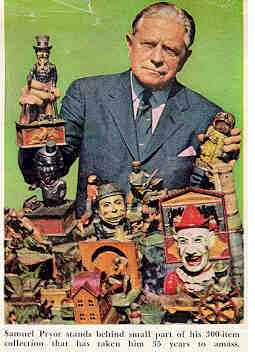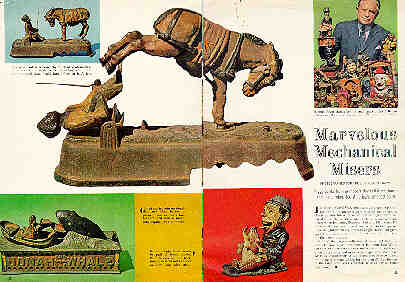Marvelous Mechanical Misers
TRUE, October 1961
 Piggy
banks from grandpa's day still lurch, bump and clang when fed America's smallest coins.
Piggy
banks from grandpa's day still lurch, bump and clang when fed America's smallest coins.
Just after the Civil War, Americans developed a passion for thrift. Youngsters were
spurred on to greater efforts of miserliness by acquisition of ingeniously contrived banks
that made satisfying clanking and whirring noises when fed coins. Between 1876 and 1886,
some 175 different designs were turned out; as was to be expected these delightfully heavy
mechanical gimcracks had great appeal for adult males who latched onto the kid's toys for
their own pleasure.
One of the largest collectors of these old banks is Samuel Pryor, a vice president of Pan
American World Airways. Pryor has been gathering banks since 1925, and a few of the rarer
and more active types are shown here. Recently, duplications of the originals have been
placed on the market, some selling for less than $5, But for one of the rarer prototypes,
collectors have to pay 20 times that amount.

ALTOONA MIRROR - July 24, 1965
Tyrone Man's Penny Bank Collection Among
Country's Finest
Retired Banker John Meyer Spent 30 Years Collecting
By VIRGIE WERNER
"Almost everyone at heart is a collector. Some
collections are rare and costly, some cost little or nothing, but the true value
of any collection is best measured by the continuing pleasure it brings to the
collector, and one of the greatest pleasures of owning a collection is seeing it
out in the open as a tangible decorative part of a room," said John D.
Meyer retired Tyrone banker.
This was quite evident as I had the pleasure and privilege to interview him one
afternoon. The visit was rewarding to view his vast collection of unusual banks,
numerous cases of ruby and coin glass and many antique clocks, to name only
three of his collections. "When I began collecting many years ago, I got a
lot of pleasure out of acquiring these rare objects," said Mr. Meyer.
"Now my pleasure is showing them."
Recalls First Bank
With a twinkle in his eyes, Mr. Meyer recalls his very first penny bank
which was given to him in 1878 by his uncle. The bank, named Tammany, is a
figure of a little fat man to represent Boss Tweed in his palmy days. You place
a coin in his right hand and it then drops into his coat pocket and he nods his
head in appreciation. The bank is sometimes called "The Little Fat
Man." Mr. Meyer said his niece used the bank when she was a little girl and
after her it was used by her three daughters in turn. His niece returned the
bank to him in 1937 and it became the inspiration for his collection of old
penny banks.
The bank is in perfect condition although it does look a little as though the
trap had been tampered with in a childish effort to get the pennies out.
"Although it is one of the common banks, to me it is the most prized one in
my whole collection and I keep it protected under a glass dome." Mr. Meyer
said.
International Reputation
Mr. Meyer has gained an international reputation as one of the most
important private collectors of mechanical banks. His name synonymous with the
other greats; Andrew Emerine of Fostoria, Ohio; W. F. Ferguson of New Rochelle,
N. Y.; Jones of Cleveland; Richard Hegarty of Coalport, Pa.
A few years back the retired banker and bank collector had written a book on
this hobby called "A Handbook of Old Mechanical Penny Banks." This
book gives complete descriptions of some 245 banks and attempts to set a uniform
system so that each might be identified readily by a dealer or collector.
This was accomplished, as today many leading dealers and catalogs describe a
certain bank by the Meyer number. The Meyer collection includes all but perhaps
20 of the banks listed in his book along with hundreds of wood, tin, glass, iron
and pottery "still" banks.
Most of the banks, Mr. Meyer said, were made between 1860 and 1910," back
in the good old days when thrift seemed a virtue," even to the extent that
foundries in Ohio and New England were competing to produce the most attractive
and best selling bank.
Like coins or stamps so far as values are concerned where only 40 or 50 of a
certain type were made, they are rarer and more valuable today.
If many of a type were made they are not as expensive now for more collectors
have them. The most valued bank in his collection is the unique "Baby
Elephant Bank," the only one known to exist.
Perhaps the next rarest in the group is known as the "Freedman's colored
cashier" and is much prized by collectors. The date of its make is not
known but the nature of the device places it soon after the Civil War so you can
see that mechanical banks encouraged thrift since the time Abraham Lincoln was
in the White House.
Glass Collection
Turning to his ruby and coin glass, Mr. Meyer explained, the star of his
collection is the famous U.S. Coin glass which was introduced at the Columbia
Exposition in Chicago in 1892. It marked the centennial of the establishment of
the United States bank and mint. Its designers did not rekon, however, with the
federal law which prohibited reproduction making the pattern rare and therefore
sought after by collectors today. His prize piece in the collection is a spooner
which is a combination of ruby and coin glass.
The Meyer clock collection consists of some 60 exceptionally fine clocks. Many
of which are museum pieces. Some are key wind, weight driven, clocks with wooden
works, clocks that require but one winding to run a year, striking clocks that
indicate the time during the night. Some are American made, others English,
Dutch, German and French origin. Some of the rarer in the collection are Eli
Terry Pillar and Scroll, Willard banjo, English shelf cuckoos, Wagon spring
Double Steeple, French and ancient wag-on-the-walls, Dickory Dock Mouse clock,
Statue and "blinking eye" character clocks, even down to horse and
buggy dash clocks.
Mr. Meyer remarked, "One of the best things about having a collection is
sharing it, so please come back sometime."
Mr. Meyer is looking forward to his 91st birthday Aug. 4 and with his many
hobbies and interest in youth, along with civic projects in the community, I am
sure that Mr. Meyer will remain as Tyrone's "youngest citizen" for
many more years to come.
Mr. Meyer has won wide recognition for his varied activities in state and
national banking and is a member of the 50-Year club of Pennsylvania Bankers
Association. He serves as a dedicated trustee of both Franklin and Marshall
College and Hood College. His distinguished banking career began in 1909, and
before retiring at the age of 89, he served as president of the First Blair
County National Bank of Tyrone.
(Web Note: Due to poor quality, Photos in the original
article were not reproduced.)
